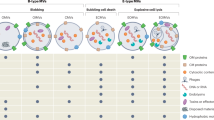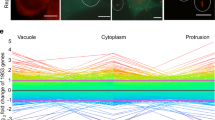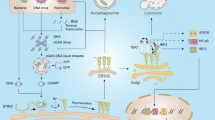Abstract
Once considered to be contained, infectious diseases of bacterial origin are now making a comeback. A lack of innovative therapies and the appearance of drug-resistant pathogens are becoming increasingly serious problems. A better understanding of pathogen–host interactions at the cellular and molecular levels is necessary to define new targets in our fight against microorganisms. In the past few years, the merging of cell biology and microbiology has started to yield critical and often surprising new information on the interactions that occur between various pathogens and their mammalian host cells. Here we focus on the intracellular routing of vacuoles containing microorganisms, as well as on the bacterial effectors and their host-cell targets that control vacuole maturation. We also describe new approaches for isolating microorganism-containing vacuoles and analysing their molecular composition, which will help researchers to define the molecules and mechanisms governing vacuole biogenesis.
This is a preview of subscription content, access via your institution
Access options
Subscribe to this journal
Receive 12 print issues and online access
$209.00 per year
only $17.42 per issue
Buy this article
- Purchase on Springer Link
- Instant access to full article PDF
Prices may be subject to local taxes which are calculated during checkout


Similar content being viewed by others
References
Sinai, A. P. & Joiner, K. A. Safe haven: the cell biology of nonfusogenic pathogen vacuoles. Annu. Rev. Microbiol. 51, 415–462 (1997).
Schlesinger, L. S. Macrophage phagocytosis of virulent but not attenuated strains of Mycobacterium tuberculosis is mediated by mannose receptors in addition to complement receptors . J. Immunol. 150, 2920– 2930 (1993).
Horwitz, M. A. Phagocytosis of the Legionnaires’ disease bacterium (Legionella pneumophila) occurs by a novel mechanism: engulfment within a pseudopod coil. Cell 36, 27–33 ( 1984).
Rittig, M. G. et al. Coiling phagocytosis of trypanosomatids and fungal cells. Infect. Immun. 66, 4331–4339 (1998).
Mengaud, J., Ohayon, H., Gounon, P., Mege, R. M. & Cossart, P. E-cadherin is the receptor for internalin, a surface protein required for entry of L. monocytogenes into epithelial cells. Cell 84, 923–932 ( 1996).
Lecuit, M. et al. A single amino acid in E-cadherin responsible for host specificity towards the human pathogen Listeria monocytogenes. EMBO J. 18, 3956–3963 (1999).
Kubori, T. et al. Supramolecular structure of the Salmonella typhimurium type III protein secretion system. Science 280, 602 –605 (1998).
Hueck, C. J. Type III protein secretion systems in bacterial pathogens of animals and plants . Microbiol. Mol. Biol. Rev. 62, 379– 433 (1998).
Zhou, D., Mooseker, M. S. & Galan, J. E. Role of the S. typhimurium actin-binding protein SipA in bacterial internalization. Science 283, 2092–2095 (1999).
Hayward, R. D. & Koronakis, V. Direct nucleation and bundling of actin by the SipC protein of invasive Salmonella. EMBO J. 18, 4926–4934 ( 1999).
Hardt, W. D., Chen, L. M., Schuebel, K. E., Bustelo, X. R. & Galan, J. E. S. typhimurium encodes an activator of Rho GTPases that induces membrane ruffling and nuclear responses in host cells. Cell 93, 815–826 (1998).
Nhieu, G. T. & Sansonetti, P. J. Mechanism of Shigella entry into epithelial cells. Curr. Opin. Microbiol. 2, 51–55 (1999).
Menard, R., Sansonetti, P., Parsot, C. & Vasselon, T. Extracellular association and cytoplasmic partitioning of the IpaB and IpaC invasins of S. flexneri. Cell 79, 515– 525 (1994).
Tran Van Nhieu, G., Caron, E., Hall, A. & Sansonetti, P. J. IpaC induces actin polymerization and filopodia formation during Shigella entry into epithelial cells. EMBO J. 18, 3249– 3262 (1999).
Desjardins, M., Huber, L. A., Parton, R. G. & Griffiths, G. Biogenesis of phagolysosomes proceeds through a sequential series of interactions with the endocytic apparatus. J. Cell Biol. 124, 677–688 (1994).
Novick, P. & Zerial, M. The diversity of Rab proteins in vesicle transport. Curr. Opin. Cell Biol. 9, 496–504 (1997).
Mayorga, L. S., Bertini, F. & Stahl, P. D. Fusion of newly formed phagosomes with endosomes in intact cells and in a cell-free system. J. Biol. Chem. 266, 6511–6517 (1991).
Desjardins, M. Biogenesis of phagolysosomes: the ‘kiss and run’ hypothesis. Trends Cell Biol. 5, 183–186 (1995).
Andrews, N. W. Lysosome recruitment during host cell invasion by Trypanosoma cruzi. Trends Cell Biol. 5, 133–137 (1995).
Dramsi, S. & Cossart, P. Intracellular pathogens and the actin cytoskeleton. Annu. Rev. Cell Dev. Biol. 14, 137–166 (1998).
High, N., Mounier, J., Prevost, M. C. & Sansonetti, P. J. IpaB of Shigella flexneri causes entry into epithelial cells and escape from the phagocytic vacuole. EMBO J. 11, 1991 –1999 (1992).
Heinzen, R. A., Grieshaber, S. S., Van Kirk, L. S. & Devin, C. J. Dynamics of actin-based movement by Rickettsia rickettsii in vero cells. Infect. Immun. 67, 4201–4207 (1999).
Cossart, P. & Lecuit, M. Interactions of Listeria monocytogenes with mammalian cells during entry and actin-based movement: bacterial factors, cellular ligands and signaling. EMBO J. 17, 3797–3806 (1998).
Geoffroy, C., Gaillard, J. L., Alouf, J. E. & Berche, P. Purification, characterization, and toxicity of the sulfhydryl-activated hemolysin listeriolysin O from Listeria monocytogenes. Infect. Immun. 55, 1641–1646 (1987).
Alvarez-Dominguez, C., Barbieri, A. M., Beron, W., Wandinger-Ness, A. & Stahl, P. D. Phagocytosed live Listeria monocytogenes influences Rab5-regulated in vitro phagosome-endosome fusion. J. Biol. Chem. 271, 13834–13843 (1996).
Alvarez-Dominguez, C., Roberts, R. & Stahl, P. D. Internalized Listeria monocytogenes modulates intracellular trafficking and delays maturation of the phagosome. J. Cell Sci. 110, 731–743 ( 1997).
Alvarez-Dominguez, C. & Stahl, P. D. Increased expression of Rab5a correlates directly with accelerated maturation of Listeria monocytogenes phagosomes. J. Biol. Chem. 274, 11459– 11462 (1999).
Suss-Toby, E., Zimmerberg, J. & Ward, G. E. Toxoplasma invasion: the parasitophorous vacuole is formed from host cell plasma membrane and pinches off via a fission pore . Proc. Natl Acad. Sci. USA 93, 8413– 8418 (1996).
Joiner, K. A., Fuhrman, S. A., Miettinen, H. M., Kasper, L. H. & Mellman, I. Toxoplasma gondii: fusion competence of parasitophorous vacuoles in Fc receptor-transfected fibroblasts. Science 249, 641–646 ( 1990).
Schwab, J. C., Beckers, C. J. & Joiner, K. A. The parasitophorous vacuole membrane surrounding intracellular Toxoplasma gondii functions as a molecular sieve. Proc. Natl Acad. Sci. USA 91, 509– 513 (1994).
Vogel, J. P. & Isberg, R. R. Cell biology of Legionella pneumophila . Curr. Opin. Microbiol. 2, 30– 34 (1999).
Segal, G. & Shuman, H. A. How is the intracellular fate of the Legionella pneumophila phagosome determined? Trends Microbiol. 6, 253–255 (1998).
Kirby, J. E. & Isberg, R. R. Legionnaires’ disease: the pore macrophage and the legion of terror within. Trends Microbiol. 6, 256–258 ( 1998).
Zuckman, D. M., Hung, J. B. & Roy, C. R. Pore-forming activity is not sufficient for legionella pneumophila phagosome trafficking and intracellular growth. Mol. Microbiol. 32, 990–1001 (1999).
Roy, C. R. & Isberg, R. R. Topology of Legionella pneumophila DotA: an inner membrane protein required for replication in macrophages. Infect. Immun. 65, 571–578 (1997).
Roy, C. R., Berger, K. H. & Isberg, R. R. Legionella pneumophila DotA protein is required for early phagosome trafficking decisions that occur within minutes of bacterial uptake. Mol. Microbiol. 28, 663– 674 (1998).
Coers, J., Monahan, C. & Roy, C. R. Modulation of phagosome biogenesis by Legionella pneumophila creates an organelle permissive for intracellular growth. Nature Cell Biol. (in the press).
Andrews, H. L., Vogel, J. P. & Isberg, R. R. Identification of linked Legionella pneumophila genes essential for intracellular growth and evasion of the endocytic pathway. Infect. Immun. 66, 950–958 (1998).
Matsumoto, A., Bessho, H., Uehira, K. & Suda, T. Morphological studies of the association of mitochondria with chlamydial inclusions and the fusion of chlamydial inclusions. J. Electron Microsc. 40, 356–363 (1991).
Scidmore, M. A., Fischer, E. R. & Hackstadt, T. Sphingolipids and glycoproteins are differentially trafficked to the Chlamydia trachomatis inclusion. J. Cell Biol. 134, 363–374 (1996).
Boleti, H., Benmerah, A., Ojcius, D. M., Cerf-Bensussan, N. & Dautry-Varsat, A. Chlamydia infection of epithelial cells expressing dynamin and eps15 mutants: clathrin-independent entry into cells and dynamin-dependent productive growth. J. Cell Sci. 112, 1487–1496 (1999).
Scidmore-Carlson, M. A., Shaw, E. I., Dooley, C. A., Fischer, E. R. & Hackstadt, T. Identification and characterization of a Chlamydia trachomatis early operon encoding four novel inclusion membrane proteins. Mol. Microbiol. 33, 753– 765 (1999).
Pizarro-Cerda, J. et al. Brucella abortus transits through the autophagic pathway and replicates in the endoplasmic reticulum of nonprofessional phagocytes. Infect. Immun. 66, 5711–5724 (1998).
Sola-Landa, A. et al. A two-component regulatory system playing a critical role in plant pathogens and endosymbionts is present in Brucella abortus and controls cell invasion and virulence. Mol. Microbiol. 29, 125–138 (1998).
O’Callaghan, D. et al. A homologue of the Agrobacterium tumefaciens BirB and Bordetella pertussis Ptl Type IV secretion system is essential for intracellular survival of Brucella suis. Mol. Microbiol. 33 , 1210–1220 (1999).
Hsia, R. C., Pannekoek, Y., Ingerowski, E. & Bavoil, P. M. Type III secretion genes identify a putative virulence locus of Chlamydia . Mol. Microbiol. 25, 351–359 (1997).
Deretic, V. & Fratti, R. A. Mycobacterium tuberculosis phagosome . Mol. Microbiol. 31, 1603– 1609 (1999).
Sturgill-Koszycki, S. et al. Lack of acidification in Mycobacterium phagosomes produced by exclusion of the vesicular proton-ATPase. Science 263, 678–681 (1994).
Via, L. E. et al. Arrest of mycobacterial phagosome maturation is caused by a block in vesicle fusion between stages controlled by rab5 and rab7. J. Biol. Chem. 272, 13326–13331 (1997).
de Chastellier, C., Lang, T. & Thilo, L. Phagocytic processing of the macrophage endoparasite, Mycobacterium avium, in comparison to phagosomes which contain Bacillus subtilis or latex beads . Eur. J. Cell Biol. 68, 167– 182 (1995).
Sturgill-Koszycki, S., Schaible, U. E. & Russell, D. G. Mycobacterium-containing phagosomes are accessible to early endosomes and reflect a transitional state in normal phagosome biogenesis . EMBO J. 15, 6960–6968 (1996).
Ferrari, G., Langen, H., Naito, M. & Pieters, J. A coat protein on phagosomes involved in the intracellular survival of mycobacteria. Cell 97, 435–447 ( 1999).
Rauchenberger, R., Hacker, U., Murphy, J., Niewohner, J. & Maniak, M. Coronin and vacuolin identify consecutive stages of a late, actin-coated endocytic compartment in Dictyostelium. Curr. Biol. 7, 215–218 ( 1997).
de Hostos, E. L. The coronin family of actin-associated proteins. Trends Cell Biol. 9, 345–350 ( 1999).
Scianimanico, S. et al. Impaired recruitment of the small GTPase rab7 correlates with the inhibition of phagosome maturation by Leishmania donovani promastigotes . Cell. Microbiol. 1, 19– 32 (1999).
Desjardins, M. & Descoteaux, A. Inhibition of phagolysosomal biogenesis by the Leishmania lipophosphoglycan. J. Exp. Med. 185, 2061–2068 (1997).
Russell, D. G., Xu, S. & Chakraborty, P. Intracellular trafficking and the parasitophorous vacuole of Leishmania mexicana-infected macrophages. J. Cell Sci. 103, 1193–1210 (1992).
Steele-Mortimer, O., Méresse, S., Toh, B.-H., Gorvel, J.-P. & Finlay, B. B. Biogenesis of Salmonella typhimurium-containing vacuoles in epithelial cells involves interactions with the early endocytic pathway. Cell. Microbiol. 1, 33– 50 (1999).
Garcia-del Portillo, F. & Finlay, B. B. Targeting of Salmonella typhimurium to vesicles containing lysosomal membrane glycoproteins bypasses compartments with mannose 6-phosphate receptors. J. Cell Biol. 129, 81–97 ( 1995).
Méresse, S., Steele-Mortimer, O., Finlay, B. B. & Gorvel, J.-P. The rab7 GTPase controls the maturation of Salmonella typhimurium-containing vacuole in HeLa cells. EMBO J. 18, 4394– 4403 (1999).
Garcia-del Portillo, F., Zwick, M. B., Leung, K. Y. & Finlay, B. B. Salmonella induces the formation of filamentous structures containing lysosomal membrane glycoproteins in epithelial cells. Proc. Natl Acad. Sci. USA 90, 10544–10548 ( 1993).
Cuervo, A. M. & Dice, J. F. A receptor for the selective uptake and degradation of proteins by lysosomes. Science 273 , 501–503 (1996).
Hensel, M. et al. Genes encoding putative effector proteins of the type III secretion system of Salmonella pathogenicity island 2 are required for bacterial virulence and proliferation in macrophages. Mol. Microbiol. 30, 163–174 (1998).
Uchiya, K. et al. A Salmonella virulence protein that inhibits cellular trafficking . EMBO J. 18, 3924–3933 (1999).
Schiavo, G. et al. Tetanus and botulinum-B neurotoxins block neurotransmitter release by proteolytic cleavage of synaptobrevin. Nature 359, 832–835 (1992).
Schaible, U. E., Sturgill-Koszycki, S., Schlesinger, P. H. & Russell, D. G. Cytokine activation leads to acidification and increases maturation of Mycobacterium avium-containing phagosomes in murine macrophages. J. Immunol. 160, 1290–1296 ( 1998).
Via, L. E. et al. Effects of cytokines on mycobacterial phagosome maturation . J. Cell Sci. 111, 897– 905 (1998).
Alvarez-Dominguez, C. & Stahl, P. D. Interferon-gamma selectively induces Rab5a synthesis and processing in mononuclear cells. J. Biol. Chem. 273, 33901–33904 (1998).
Tanaka, T. et al. Targeted disruption of the NF-IL6 gene discloses its essential role in bacteria killing and tumor cytotoxicity by macrophages. Cell 80, 353–361 ( 1995).
Pizarro-Cerda, J., Desjardins, M., Moreno, E., Akira, S. & Gorvel, J. P. Modulation of endocytosis in nuclear factor IL-6(–/–) macrophages is responsible for a high susceptibility to intracellular bacterial infection. J. Immunol. 162 , 3519–3526 (1999).
Skamene, E. Genetic control of susceptibility to infections with intracellular pathogens . Pathol. Biol. 46, 689– 692 (1998).
Cellier, M. et al. Nramp defines a family of membrane proteins. Proc. Natl Acad. Sci. USA 92, 10089–10093 (1995).
Gruenheid, S., Pinner, E., Desjardins, M. & Gros, P. Natural resistance to infection with intracellular pathogens: the Nramp1 protein is recruited to the membrane of the phagosome. J. Exp. Med. 185, 717–730 (1997).
Cellier, M., Belouchi, A. & Gros, P. Resistance to intracellular infections: comparative genomic analysis of Nramp. Trends Genet. 12, 201–204 (1996).
Agranoff, D. D. & Krishna, S. Metal ion homeostasis and intracellular parasitism. Mol. Microbiol. 28, 403–412 (1998).
Hensel, M. et al. Simultaneous identification of bacterial virulence genes by negative selection. Science 269, 400– 403 (1995).
Valdivia, R. H. & Falkow, S. Fluorescence-based isolation of bacterial genes expressed within host cells. Science 277, 2007–2011 ( 1997).
Strauss, E. J. & Falkow, S. Microbial pathogenesis: genomics and beyond. Science 276, 707– 712 (1997).
Shea, J. E., Hensel, M., Gleeson, C. & Holden, D. W. Identification of a virulence locus encoding a second type III secretion system in Salmonella typhimurium. Proc. Natl Acad. Sci. USA 93, 2593–2597 (1996).
Wilkins, M. R., Sanchez, J. C., Williams, K. L. & Hochstrasser, D. F. Current challenges and future applications for protein maps and post-translational vector maps in proteome projects. Electrophoresis 17 , 830–838 (1996).
Chakraborty, P., Sturgill-Koszycki, S. & Russell, D. G. Isolation and characterization of pathogen-containing phagosomes. Methods Cell Biol. 45, 261– 276 (1994).
Mills, S. D. & Finlay, B. B. Isolation and characterization of Salmonella typhimurium and Yersinia pseudotuberculosis-containing phagosomes from infected mouse macrophages: Y. pseudotuberculosis traffics to terminal lysosomes where they are degraded. Eur. J. Cell Biol. 77, 35–47 (1998).
Lindberg, A. A. Vaccination against enteric pathogens: from science to vaccine trials. Curr. Opin. Microbiol. 1, 116–124 (1998).
Russmann, H. et al. Delivery of epitopes by the Salmonella type III secretion system for vaccine development. Science 281, 565–568 (1998).
Kaufmann, S. H. & Hess, J. Impact of intracellular location of and antigen display by intracellular bacteria: implications for vaccine development. Immunol. Lett. 65, 81–84 (1999).
Acknowledgements
We thank J. Ewbank, A. Labrousse and M.J. Martinez for helpful comments and suggestions. This work was supported by the CNRS (PICS 558), INSERM (J.-P.G., S.M. and E.M.) and grants from the Medical Research Council of Canada (M.D. and B.F.).
Author information
Authors and Affiliations
Corresponding author
Rights and permissions
About this article
Cite this article
Méresse, S., Steele-Mortimer, O., Moreno, E. et al. Controlling the maturation of pathogen-containing vacuoles: a matter of life and death. Nat Cell Biol 1, E183–E188 (1999). https://doi.org/10.1038/15620
Issue Date:
DOI: https://doi.org/10.1038/15620
This article is cited by
-
Renal protein reabsorption impairment related to a myxosporean infection in the grass frog (Rana temporaria L.)
Parasitology Research (2023)
-
Quantitative methods for assessing local and bodywide contributions to Wolbachia titer in maternal germline cells of Drosophila
BMC Microbiology (2019)
-
Deciphering host lysosome-mediated elimination of Plasmodium berghei liver stage parasites
Scientific Reports (2019)
-
Nutrient scavenging in cancer
Nature Reviews Cancer (2018)
-
The Voltage-Dependent Anion Channels (VDAC) of Mycobacterium avium phagosome are associated with bacterial survival and lipid export in macrophages
Scientific Reports (2017)



